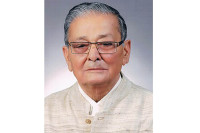National
Multidimensional poverty slumped in Nepal before Covid-19, global report says
Earlier, a national report had warned that the Covid-19 pandemic could disrupt the past gains.
Prithvi Man Shrestha
Nepal and India made rapid progress towards reducing multidimensional poverty in the years before the Covid-19 pandemic hit the world, a new global report on multidimensional poverty says.
In 2011, 39 percent of Nepalis were multidimensionally poor and the percentage dipped to 25.7 in 2016 and 17.5 in 2019, according to the report. “It means 5.13 million Nepalis are multidimensionally poor based on Nepal’s total population of 29,192,480 as per the census 2021,” said Dharma Swarnakar, policy advisor at the United Nations Development Program (UNDP), Nepal at a press briefing on Monday.
The report, Global Multidimensional Poverty Index 2022, was prepared by the UNDP in coordination with the Oxford Poverty and Human Development Initiative and was released on Monday.
The report has lauded the improvement Nepal made in the area of sanitation which led to sharp reduction in multidimensional poverty.
“This progress has been accompanied by notable improvements in sanitation, which saw the largest reduction in the percentage of people deprived in this indicator—from 60.6 percent in 2011 to 35.9 percent in 2016 and 21.4 percent in 2019, among the whole population, according to the report.
Multidimensional Poverty Index (PMI) is measured based on deprivation across three sectors and 10 sub-sectors—health (child mortality, nutrition), education (years of schooling, enrollment), and living standards (water, sanitation, electricity, cooking fuel, floor, and assets).
“Improvements in sanitation (in Nepal) are highly correlated with improvements in other health indicators, such as child nutrition, child mortality and access to drinking water,” the report, which has assessed Nepal’s situation as a case study, states. “A growing body of evidence points to the positive health benefits of having access to an improved sanitation facility and drinking water on child health and wellbeing through lower diarrhoeal incidence, a leading cause of child mortality in developing countries.”
According to the report, Nepal’s status is better compared to average multidimensional poverty of 20.5 percent in South Asia.
Along with Nepal, India also made rapid progress with the South Asian giant reducing multidimensional poverty to 16.4 percent in the 2019-2021 period from 55.1 percent in 2005-06.
In South Asia, the war-torn Afghanistan has the worst multidimensional poverty of 55.9 percent followed by Pakistan with 38.3 percent and Bangladesh with 24.6 percent.
Before the Covid and recent economic turmoil, Sri Lanka’s only 2.9 percent population was under multidimensional poverty while 0.8 percent of the population of the Maldives was in multidimensional poverty.
The new report has not calculated the impact of Covid-19 on the multidimensional poverty in Nepal and across the world. Nepal’s national report on multidimensional poverty released in August, 2021 warned that progress made by Nepal could be in doubt with the pandemic pushing the poor further into poverty.
The global report has also pointed out the pessimistic scenario in global multidimensional poverty reduction due to the pandemic.
“Recent estimates suggest that the most pessimistic scenarios are plausible,” the report says. “Updated data from the United Nations Educational, Scientific and Cultural Organisation show that, on average, students across the globe lost half a year in schooling due to the pandemic—broadly consistent with the earlier simulation result that half of children stopped attending school during the first year of the pandemic.”
The report also pointed out the most recent data on food insecurity from the World Food Programme, which had suggested that the number of people living in a food crisis or worse increased to 193 million in 2021.




 8.12°C Kathmandu
8.12°C Kathmandu















